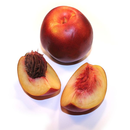Showing Food Nectarine
| General Information | |||||||||||
|---|---|---|---|---|---|---|---|---|---|---|---|
| Name | Nectarine | ||||||||||
| Scientific Name | Prunus persica var. nucipersica | ||||||||||
| Description | The variety P. persica var. nucipersica (or var. nectarina), commonly called nectarine, has a smooth skin. It is on occasion referred to as a "shaved peach", "fuzzy-less peach", "juicy peach", or "Brazilian peach" due to its lack of fuzz or short hairs. Though fuzzy peaches and nectarines are regarded commercially as different fruits, with nectarines often erroneously believed to be a crossbreed between peaches and plums, or a "peach with a plum skin", nectarines belong to the same species as peaches. Several genetic studies have concluded nectarines are produced due to a recessive allele, whereas a fuzzy peach skin is dominant. Nectarines have arisen many times from peach trees, often as bud sports. As with peaches, nectarines can be white or yellow, and clingstone or freestone. On average, nectarines are slightly smaller and sweeter than peaches, but with much overlap. The lack of skin fuzz can make nectarine skins appear more reddish than those of peaches, contributing to the fruit's plum-like appearance. The lack of down on nectarines' skin also means their skin is more easily bruised than peaches. | ||||||||||
| Primary ID | FOOD00229 | ||||||||||
| Picture |  | ||||||||||
| Classification | |||||||||||
| Group | Fruits | ||||||||||
| Sub-Group | Drupes | ||||||||||
| Taxonomy | |||||||||||
| Superkingdom | Eukaryota | ||||||||||
| Kingdom | Viridiplantae | ||||||||||
| Phylum | Streptophyta | ||||||||||
| Class | Magnoliopsida | ||||||||||
| Order | Rosales | ||||||||||
| Family | Rosaceae | ||||||||||
| Genus | Prunus | ||||||||||
| Species | persica | ||||||||||
| Variety | nucipersica | ||||||||||
| External Links | |||||||||||
| ITIS ID | 530965 | ||||||||||
| Wikipedia ID | Nectarine#Nectarines | ||||||||||
| Composition | |||||||||||
| Compounds |
Processing... | ||||||||||
| Macronutrients |
Processing... | ||||||||||
| References | |||||||||||
| Content Reference | — Saxholt, E., et al. 'Danish food composition databank, revision 7.' Department of Nutrition, National Food Institute, Technical University of Denmark (2008). — U.S. Department of Agriculture, Agricultural Research Service. 2008. USDA National Nutrient Database for Standard Reference, Release 21. Nutrient Data Laboratory Home Page. — Rothwell JA, Pérez-Jiménez J, Neveu V, Medina-Ramon A, M'Hiri N, Garcia Lobato P, Manach C, Knox K, Eisner R, Wishart D, Scalbert A. (2013) Phenol-Explorer 3.0: a major update of the Phenol-Explorer database to incorporate data on the effects of food processing on polyphenol content. Database, 10.1093/database/bat070. | ||||||||||